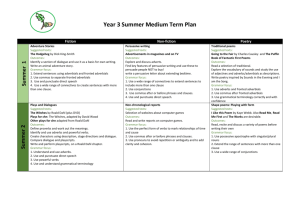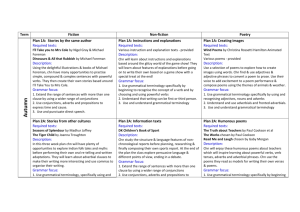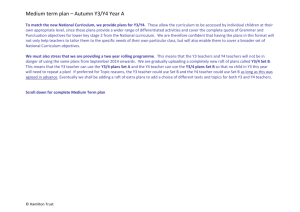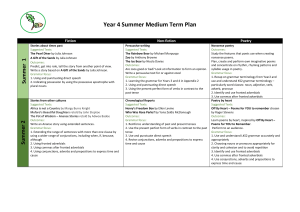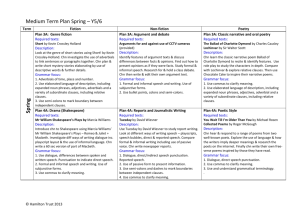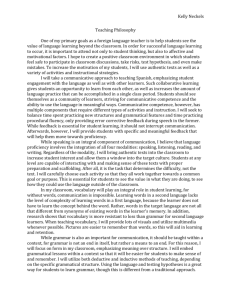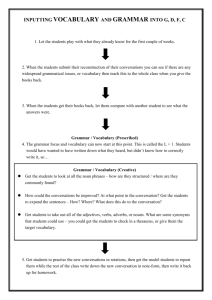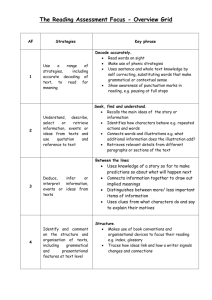Medium Term Plan
advertisement
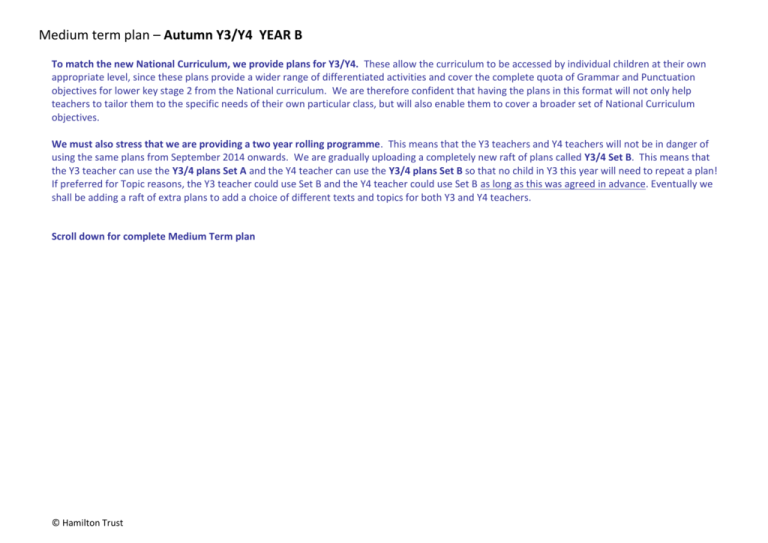
Medium term plan – Autumn Y3/Y4 YEAR B To match the new National Curriculum, we provide plans for Y3/Y4. These allow the curriculum to be accessed by individual children at their own appropriate level, since these plans provide a wider range of differentiated activities and cover the complete quota of Grammar and Punctuation objectives for lower key stage 2 from the National curriculum. We are therefore confident that having the plans in this format will not only help teachers to tailor them to the specific needs of their own particular class, but will also enable them to cover a broader set of National Curriculum objectives. We must also stress that we are providing a two year rolling programme. This means that the Y3 teachers and Y4 teachers will not be in danger of using the same plans from September 2014 onwards. We are gradually uploading a completely new raft of plans called Y3/4 Set B. This means that the Y3 teacher can use the Y3/4 plans Set A and the Y4 teacher can use the Y3/4 plans Set B so that no child in Y3 this year will need to repeat a plan! If preferred for Topic reasons, the Y3 teacher could use Set B and the Y4 teacher could use Set B as long as this was agreed in advance. Eventually we shall be adding a raft of extra plans to add a choice of different texts and topics for both Y3 and Y4 teachers. Scroll down for complete Medium Term plan © Hamilton Trust Term Fiction Poetry Plan 1B: Fables Required texts: Plan 1B: Instructions and explanations Required texts: Plan 1B: Creating images Required texts: Aesop’s Fables by Michael Rosen The Usborne Complete Book of Art ideas by Fiona Watt or close alternative Window by Jeannie Baker Various poems - provided Description: Description: This creative unit uses art activities and the book The Usborne Complete Book of Art Ideas as a vehicle for instruction writing. Chn will practise using imperative verbs and pronouns. They then learn about explanation writing. A picture is worth a thousand words? Not if you choose those words wisely! Chn explore how simile and metaphor can be used to create powerful images, though reading and discussing poems. Photographs, collage and Window by Jeannie Baker inspire chn's own image poetry.. Description: Reading a wide range of fables, including Rosen's Aesop's Fables, chn explore dialogue through drama, debate moral messages and write letters in role. Chn write their own fables, hold a festival and try them out on a live audience. Will they win rave reviews? Grammar focus: Autumn Non-fiction 1. Recognise simple sentences 2. Begin to recognise (Y3) or revise (Y4) compound and complex sentences 3. Use conjunctions to express time or cause 4. Learn how to use dialogue punctuation (Y3) or revise this (Y4) Grammar focus: 1. Use grammatical terminology specifically by beginning to recognise the concept of a verb and by choosing and using powerful verbs 2. Choose nouns and pronouns for clarity and to avoid repetition Grammar focus: Plan 2B: Stories in Familiar Settings Required texts: Plan 2B: Information texts Texts which are recommended (not essential): Plan 2B: Poetic form: Syllabic poems Required texts: Horrid Henry by Francesca Simon Horrid Henry’s Birthday Party by Francesca Simon The Kingfisher Book of Music- published by Kingfisher Children’s Book of Music -pub by Dorling Kindersley Usborne Introduction to Music: Internet Linked by Eileen O’Brien Various poems provided Description: Explore familiar settings by meeting Horrid Henry and his friends (and enemies). In particular read Horrid Henry and Horrid Henry’s Birthday Party both by Francesca Simon. Learn about and use adverbs, adverbials and prepositions. Write a new Horrid Henry story. Grammar focus: 1. Use and recognise nouns, adjectives and prepositional phrases 2. Use adverbs 3. Use adverbs and prepositions to express time and place © Hamilton Trust Description: The children read, map out and learn by heart a text about drums. They produce a shared text about the tabla drums and then use this as a model for their own report writing and an oral presentation about a chosen instrument. Grammar focus: 1. Extend the range of sentences with more than one clause by using a wider range of conjunctions 2. Use conjunctions, adverbs and prepositions to express time & cause. 3. Use grammatical terminology 1. Use grammatical terminology specifically by using and recognising adjectives, nouns and adverbs 2. Understand and use adverbials and fronted adverbials. 3. Use and understand grammatical terminology Description: Read and study haikus, tankas and cinquains recognising the syllabic structure and use of powerful verbs and descriptive language. Study the use of adverbs and adverbials to enhance the poetry. Children write some in traditional style about seasons and nature. They then use computers to manipulate images enhancing the poetry presentation. Grammar focus: 1. Use grammatical terminology specifically by beginning to recognise the concept of a verb and by choosing and using powerful verbs 2. Understand and use adverbs, adverbials and fronted adverbials.
